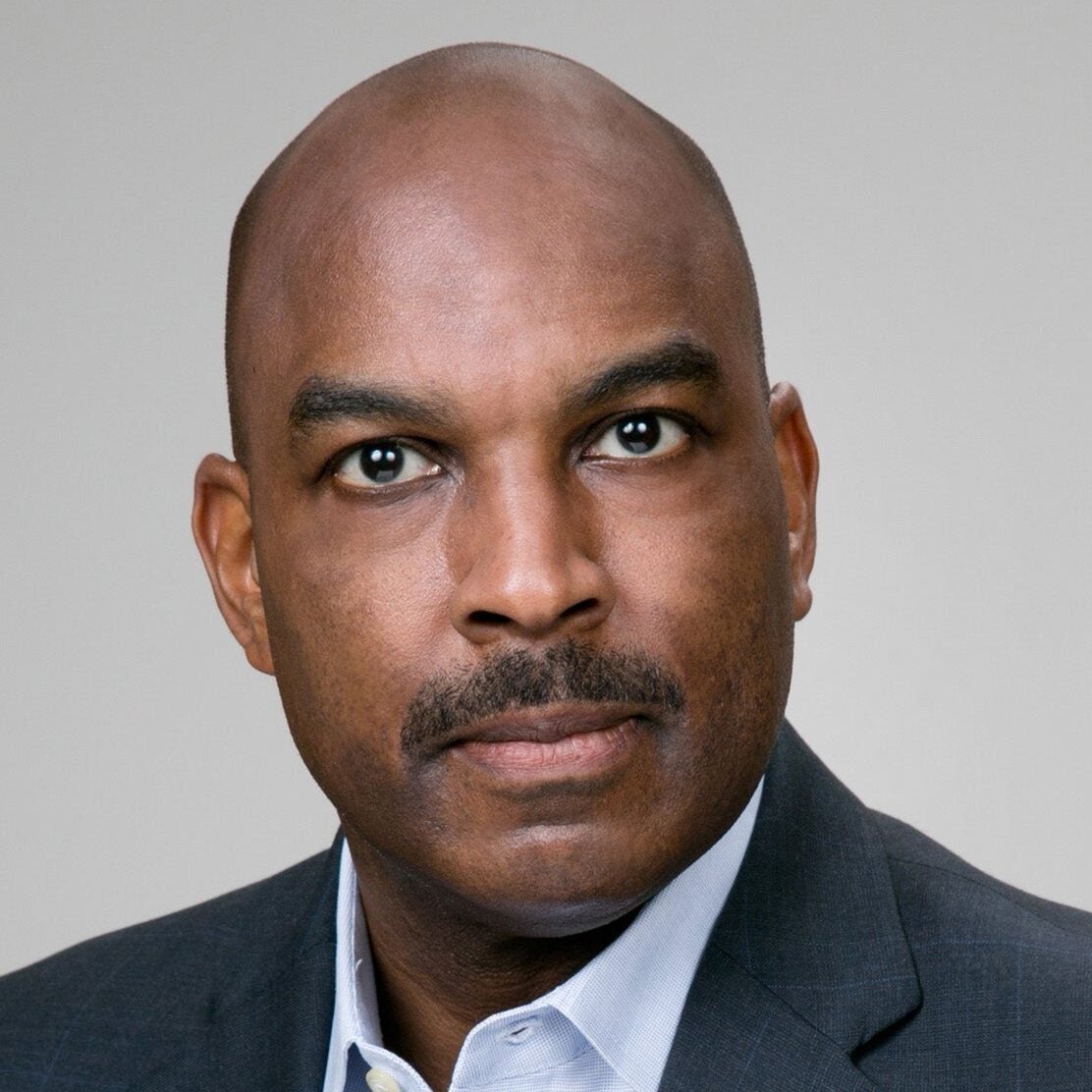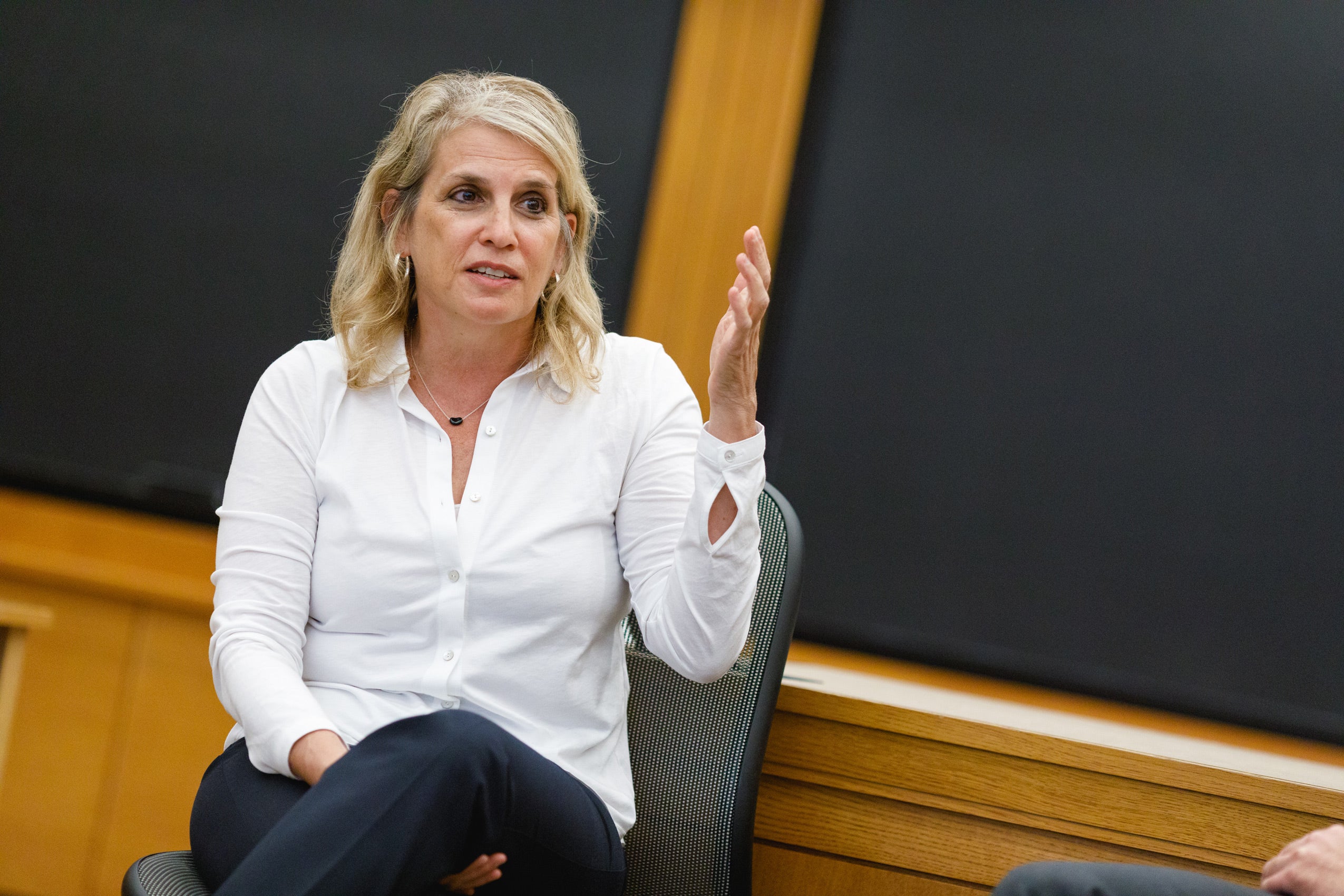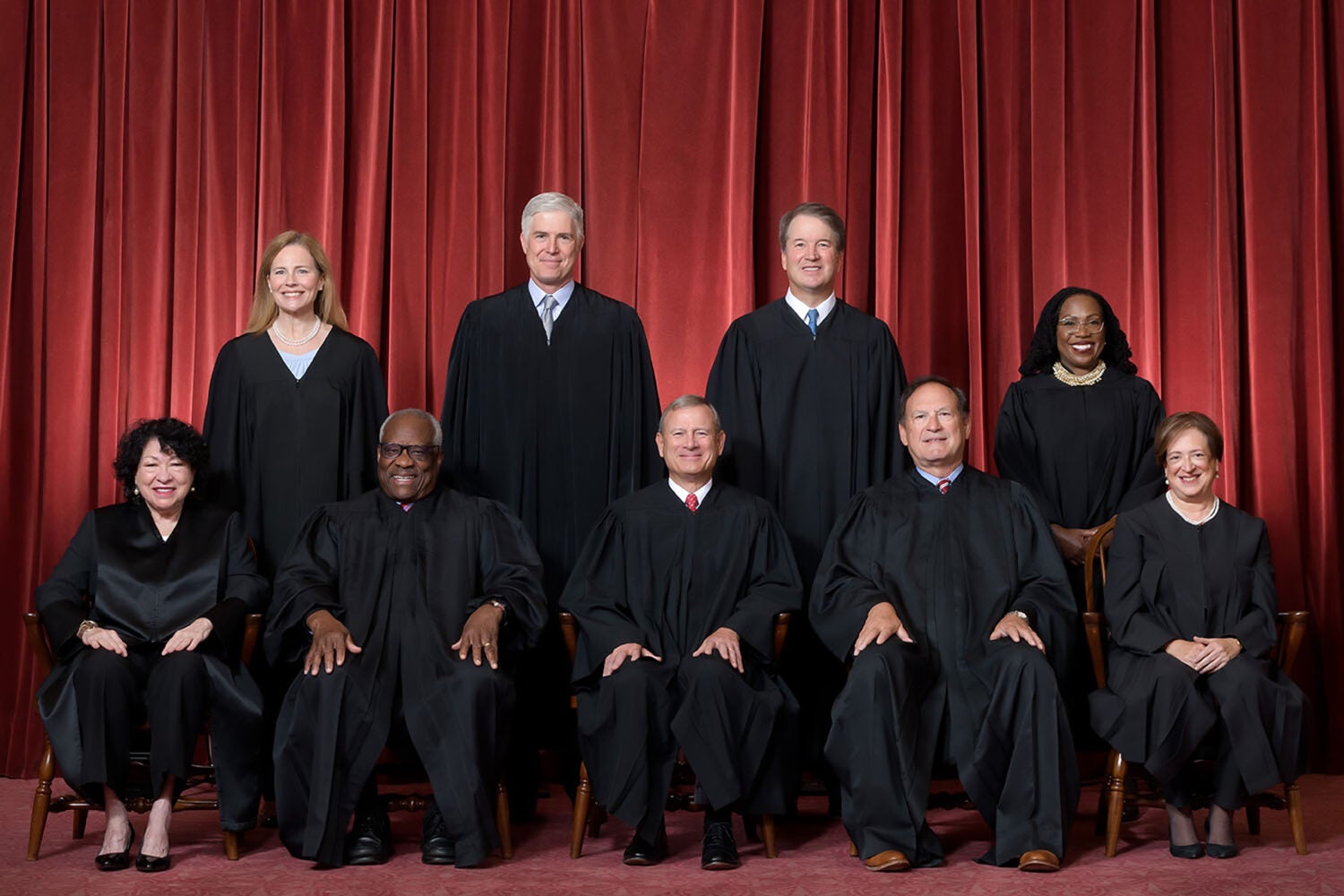As the U.S. Supreme Court wraps up another blockbuster term, Harvard Law School faculty members reflect on the ways the justices’ most recent decisions might reshape the law. From overturning the 40-year-old Chevron deference doctrine that underpins much of the modern administrative state [Loper Bright v. Raimondo], to expanding the right to challenge decades old federal regulations [Corner Post v. Federal Reserve System], to granting U.S. presidents immunity from prosecution for official acts [United States v. Trump], to upholding laws banning gun purchases by people subject to a domestic violence restraining order [United States v. Rahimi] to preserving access to the abortion pill, mifepristone [FDA v. Alliance for Hippocratic Medicine], to passing on an opportunity to rule on whether individual states can regulate global social media platforms [NetChoice v. Paxton], experts agree that the Court’s recent decisions will impact American government and society for years to come. Below, faculty offer their thoughts on some of the biggest cases and point to some clear winners and losers from the Supreme Court’s October 2023 term.
Kenneth Mack ’91, Lawrence D. Biele Professor of Law

“What seems most striking about this term, particularly in its high-profile cases such as Trump v. United States, where it ruled perhaps as broadly as it could in favor of presidential immunity from prosecution for Donald Trump and his successors in office, Alexander v. South Carolina State Conference of the NAACP, which the Court refused to defer to a district court’s finding that the state legislature’s removal of large numbers of Black voters from a congressional district was primarily based on racial considerations, and Loper Bright Enterprises v. Raimondo, where the Court overruled the well-settled Chevron doctrine, was the durability of the familiar conservative-liberal, 6-3 split in decisions on many matters of great public import. There were noteworthy exceptions, such as Justice Barrett partly agreeing the liberal justices’ assertion in Trump v. Anderson, where the Court ruled that states cannot bar presidential candidates from the ballot under Section 3 of the Fourteenth Amendment, that her conservative colleagues had issued too broad a ruling. Also of note was Fischer v. United States, involving the January 6 insurrectionists, where Justice Jackson largely agreed with the conservatives in interpreting the relevant statute narrowly, while Justice Barrett dissented, joined by Justices Sotomayor and Kagan. There were other notable cases where the Court broke from this pattern, and it’s also true that the six conservatives, in particular, disagreed at times in their reasoning even when notionally aligned. Nonetheless, the pattern remains and seems likely to persist into a future in which matters such as abortion rights and presidential power are highly likely to return to the Court.
“This is a very conservative Court that is committed to deciding matters on which Americans passionately disagree with one another, and to resolving them in a manner that reinforces the conclusion that the Court’s rulings themselves reflect the deep cleavages in American society and culture. The most recent term reinforces the perception among many in the American public that, more than in any other period of modern American history, law — whether it be the law of statutory interpretation, administrative law, or constitutional law — as reflected in the Court, is simply politics by other means.”
Martha Minow, 300th Anniversary University Professor

“Analyzing and absorbing the Supreme Court’s decisions during 2023-2024 will take time, but this much already stands out:
“The Court is closing the courthouse doors to legal consequences for individuals — including the former president — who participated in the events now known as the January 6 insurrection. The Court is depleting the authority of federal administrative agencies, including their expertise in statutory interpretation, their enforcement powers, and their ability to address smog-forming pollutants.
“In an apparent gesture of respect for another branch of government, the Court protected from challenge communications by the former president with the Department of Justice as well as communications by officials in the current White House with technology companies. Similarly signaling due regard for a sister branch, the Congress, the Court acknowledged Congress’ power to create, as it did explicitly, a stable funding structure for an agency (the Consumer Financial Protection Bureau).
“Yet the drone string, the note continuously sounded through the term, has the justices of the Supreme Court enlarging the Court’s own authority. It allowed one congressional restriction on gun possession (dealing with adjudicated perpetrators of domestic violence) and rejected another (banning devices that can enable semiautomatic rifles to fire hundreds of bullets per minute) and simultaneously shrouded from outside comprehension benchmarks for any future bipartisan gun-violence prevention efforts. And the Court recast state legislative impairment of the voting power of racial minorities by deeming the act merely partisan, not racially motivated. Asserting its own discretion to decide who can raise legal objections, the Court temporarily left in place federal statutory protection for emergency medical care (including patients in abortion contexts) and also temporarily left in place federal regulation permitting access to abortion medication. This is the Court that will decide whether the next objectors can be heard.
“Where is the Court that reminded the nation that the president — then named Nixon — was not above the law? Where are the worries about ‘judicial activism’?
“Accountability, impartiality, clarity, and durability, key attributes of the rule of law, have taken big hits. It remains to be seen how viable is the constitutional democracy that the justices are entrusted to uphold. Now, the task is up to other branches, other courts, the states, and the people, meaning: all of us.”
Richard Lazarus ’79, Charles Stebbins Fairchild Professor of Law

“First, I think this is a deeply conservative Supreme Court, and certainly far more conservative than any Supreme Court in my lifetime. There were some aberrations and some high-profile cases where the Court did not go out on a limb in some conservative way. There are some bright spots for those who tend to be more progressive, including the Rahimi case [United States v. Rahimi], in which the Court basically upheld a federal law which made it a crime to purchase a firearm if you are subject to a domestic violence restraining order. The same is true of the abortion pill case, which they threw out on the grounds of standing and the Idaho emergency abortion access case. But the bottom line is, it’s a conservative Supreme Court.
“In the biggest case on last day of the term, Trump v. United States, I can understand the chief justice’s three-part framework for the Court’s opinion, but I think, fairly understood, it’s about as big a win as President Trump could have received. The flaw in the majority opinion, for me, is not so much the framework itself, but in how the chief’s opinion for the Court applies it. It would make far more sense to have actions taken by the president within his core constitutional authority subject to presumptive, not absolute, immunity, and actions taken by the president only in the perimeter of his constitutional authority subject to presumptive nonimmunity. In each instance, the presumption would be rebuttable. The opinion, as announced, is a win for all future presidents and not just Donald Trump. Now, that may understandably cause enormous worry about what presidents will feel they can do. But any future president would have the benefits of this ruling.
“The Court’s decision to overrule Chevron deference in the Loper Bright case [Loper Bright v. Raimondo] was a convulsive shock to the legal system, because so much of lawmaking over the past 40 years has been based on this framework. For that reason, the chief justice was careful to say the ruling is prospective only, and that all prior rules that were propagated and upheld based on Chevron are not disturbed. But going forward, it’s going to be no-holds-barred because no one really understands how the courts will rule on the validity of federal regulations in absence of the Chevron precedent. The courts are now in charge of deciding what they think is the best meaning of the statutory language, giving no deference to the federal agency. As a result, we are going to have less regulation of business activity, because that requires agency rulemaking. And it’s going to affect the federal government’s ability to protect public health, the environment, all kinds of issues.
“On the Court itself, Justice Barrett was one of the clear winners. She broke with the more conservative justices in several high-profile cases. And she did so with attitude, as well. As result, she’s clearly being courted by Chief Justice Roberts, who assigned her to write several major opinions for the majority, including in the White House social media case, Murthy v. Missouri. She’s a very junior justice, but the chief wanted to reward her for her for independence. She had the breakout year.
“The person who had a breakdown year was Alito. The chief justice is normally very careful to give everyone the same number of opinions to write, plus or minus. And seniority plays a role. This term, the chief, Thomas, and Sotomayor each wrote seven. The next group — Kagan, Kavanaugh, and Gorsuch — all had six. The most junior justices, Barrett and Jackson, wrote five. Alito? Four. He’s the third most senior justice on the Court yet had only four merits opinions. That’s something!”
Sharon Block, professor of practice and executive director of the Center for Labor and a Just Economy

“From the perspective of shaping the future role of the government in protecting the public from harm, this is the most significant term of my lifetime. The only way to fully understand the consequences of the Court’s administrative law decisions this term — Jarkesy, Loper Bright, and Corner Post — is to look at them in combination. Together they constitute a project to destabilize public agencies’ ability to carry out the mission given to them by Congress where that mission involves protecting the public from corporate harm. This project is effectuated by giving those with the resources to bring a lot of litigation seemingly endless opportunities to attack the expert judgment of civil servants in how to best keep the public safe from environmental, economic and health hazards. I predict a period of great uncertainty as the courts figure out what each of these decisions mean and how they interact. Loper Bright is likely to lead to more conflicting decisions in challenges to the same regulations around the country. Corner Post means that this new dynamic may apply to regulations whose validity we thought was long settled. The result may feel like chaos and cause great strain on agency resources.”
Laurence Tribe ’66, Carl M. Loeb University Professor of Constitutional Law Emeritus

“This term was the most significant in memory because, in Trump v. United States, [the Court] hard-wired the imperial presidency by granting what in practice is close to absolute immunity from criminal prosecution to presidents who wield their power corruptly and self-servingly; and, in Loper Bright v. Raimondo, essentially deconstructed the administrative state by overruling the agency deference doctrine known as Chevron, thereby shifting government power wholesale from the agencies in the executive branch to the federal judiciary; and then, in Corner Post v. Federal Reserve Board, rendered even long-since promulgated regulations vulnerable to attack without any meaningful time limitation, delivering a one-two punch to expert agencies.
“The net effect was to seize power for federal judges, officials who serve for life and account to nobody, and to take power from Congress, both in trying to cabin the presidency with criminal laws applicable to everyone and in trying to regulate corporate power vis-à-vis consumers and the environment by passing laws that invariably cannot anticipate with precision the many circumstances in which those laws will need to be applied. At the same time, although it covered up with procedural manipulations its extension of the infamous Dobbs [v. Jackson Women’s Health] decision of 2022 to weaken protections for pregnant persons, the Court left no doubt that it intends to continue restricting personal freedom as well as voting rights without paying serious attention to its own precedent.”
Judge Nancy Gertner (Ret.), senior lecturer on law

“An unpopular, ethically challenged Supreme Court (with respect to Justices Thomas and Alito) issued a decision giving presidents sweeping immunity from criminal prosecution.
Many pundits (I included) did not expect this outcome, that is, until we listened to the oral argument before the Supreme Court. Michael Dreeben, who was enlisted by Special Counsel Jack Smith to argue the immunity case, focused on the specific allegations against former President Trump in the January 6 indictment. That’s just what Judge Chutgan of the District of Columbia District Court did, as well as the D.C. Circuit Court of Appeals. And that is what judges do in a motion to dismiss an indictment, an approach which says in effect: “We judges don’t have to address the metes and bounds of presidential immunity in all situations; we only need to determine if the indictment in front of us — that Trump conspired to overturn the result of a lawful election — alleges facts that are not immune from criminal prosecution.” Looking only at the indictment, both the district court and the court of appeals concluded that the former president did not have absolute immunity, that the prosecution could move forward. This is the approach Justice Roberts encouraged — avoiding dramatic rulings that reach beyond the narrow facts and circumstances in the case.
But the justices’ questioning at oral argument suggested a different approach. Justice Gorsuch announced that he was “not concerned about this case,” that the Court would be “writing a rule … for the ages.” They were not. Writing a “rule for the ages” is what legislatures do, or try to do, not courts. Questions from other justices in the conservative majority were less concerned about what Trump was alleged to have done and whether it could be the subject of criminal liability and more about what a possible future president might do to his predecessor. Justice Alito raised the possibility that, absent immunity, the loser in a closely contested presidential election might decline to “go off into peaceful retirement” out of fear he would be criminally prosecuted by the winner. It was as if they had in mind not Trump the defendant but Trump the future rogue president.
What did they do to protect ex-presidents? They made it worse.
They carved out immunity for certain core constitutional duties of the president, like the pardon power, even though “core powers” were not at all involved in the case in front of them. They created presumptive immunity for other “official acts” but the “presumptive” label was a ruse. To defeat immunity, a prosecutor would have to prove the negative, that in criminalizing the behavior there was “no danger of intrusion on the authority of the Executive Branch.” And the determination of presumptive immunity had to be done with one hand tied behind one’s back; the motive of the president, who, for example, instructed Vice President Pence to delay the certification as part of the false elector scheme, is irrelevant in any future prosecution, the Court said. Indeed, once a court determined that an act was immune, it could not be admitted in evidence even in a prosecution for nonimmune conduct.
Finally, to determine what fit inside or outside the immunity protection required an elaborate factual determination — way beyond the four corners of the indictment. (In fact, Judge Roberts’ majority opinion was defensive; the complexity of the issue — not the desire to make certain that no trials involving former President Trump took place before the election — explained why this decision was the last of the term and why the Court cavalierly ignored the rulings of one of the most respected lower courts in the country.)
The breadth of the decision is stunning, inventing standards and tests nowhere in the Constitution, its history or tradition. Indeed, it reminded me of Justice Alito’s criticism of Roe v. Wade in Dobbs v. Jackson Women’s Health Organization. “Without any grounding in constitutional test, history or precedent, Roe imposed on the entire country a detailed set of rules for pregnancy divided into trimesters much like those one might expect to find in a statute or regulation.” Just so.
Even less judicial was Justice Thomas’ concurrence on an issue not remotely relevant to the question presented or the parties’ briefs. He took aim at the Special Counsel’s authority to bring the charges, only days after Trump’s attorneys made the same argument in a Florida courtroom.
To be sure, official acts of a former president will be immunized under this decision; no new president, bent on retribution against his predecessor, can prosecute him for them. But also immunized are the actions of the sitting president, now in a position to do much, much worse — like directing the Internal Revenue Service to audit his predecessor or ordering the DOJ to find phony evidence of a former president’s private misconduct which can be prosecuted. (That, of course, is not far-fetched. Trump was alleged to have leaned on the DOJ to lie by announcing voter fraud in the 2020 election, “Just say it was corrupt and leave the rest to me and the Republican congressmen.”) As Justice Sotomayor said in her dissent: When [the president] uses his official powers in any way, under the majority’s reasoning, he now will be insulated from criminal prosecution. Orders the Navy’s Seal Team 6 to assassinate a political rival? Immune. Organizes a military coup to hold onto power? Immune. Takes a bribe in exchange for a pardon? Immune. Immune. Immune. Immune.”
And then there was the fact that Justices Thomas and Alito participated at all in this momentous case from which they should have been recused — Thomas because his wife, Ginni, was at the January 6 event, and had been texting Mark Meadows, the Trump’s former advisor, urging him not to concede the election; Alito because of the flags outside his homes shortly after January 6, one of which was carried by the insurrectionists. Some have called this decision Bush v. Gore, which gave George Bush the presidency. That isn’t an apt comparison. It is Dred Scott, or Plessy, or any other decision that is manifestly inconsistent with a constitutional democracy.
Noah Feldman, Felix Frankfurter Professor of Law

In a series of recent columns in Bloomberg Opinion, Noah Feldman weighed in on some of the Supreme Court’s most noteworthy decisions. The first few paragraphs of four of them are excerpted here.
Social media and the First Amendment: “In a blockbuster decision, the US Supreme Court has held for the first time that social media platforms, just like newspapers, have First Amendment rights that bar the government from forcing them to leave up or take down content. The decision, Moody v. NetChoice, can be understood as the Brown v. Board of Education of the emerging field of social media law: It establishes basic principles and rights that the courts will use to shape the evolution of the social media industry in the US and beyond. The majority opinion … technically sent the case back to the lower courts for a do-over. But in the process of telling the lower courts what they should do, the majority opinion laid out the free-speech principles that apply to social media. That’s what makes the case so important.”
Presidential immunity: “In a sweeping decision that constitutionalizes the modern reality of the imperial presidency, the US Supreme Court has established near-total criminal immunity for Donald Trump’s official acts while he was president. It’s an outcome that would have astonished the nation’s founders, who feared precisely that if the chief executive amassed too much power, the republic would turn into an empire. The conservative majority in the 6-3 decision left a little bit of room to prosecute Trump for unofficial or private acts committed while in office. But it defined such acts narrowly and said lower courts couldn’t examine Trump’s motives when determining whether a given act was official or not. The result will mean that most, maybe all the federal criminal charges against Trump for conduct related to Jan. 6 will get dismissed. And none has any realistic chance of going to trial before the presidential election in November.”
Federal agency authority: “The US Supreme Court has overruled the Chevron decision, a basic building block of administrative law, thereby striking a blow against the power and authority of all federal agencies, including the Environmental Protection Agency. The ruling, in the cases of Loper Bright Enterprises v. Raimondo and Relentless v. Department of Commerce, marks the culmination of the conservative revolution at the court, joining recent landmark decisions overturning abortion rights, barring affirmative action, expanding gun rights and more. Although the 40-year-old Chevron precedent was mostly unknown to non-lawyers until recently, overturning it will have profound consequences for the legal system and the whole apparatus of government through regulation.”
The Second Amendment: “Gun rights are not unlimited according to an 8-1 Supreme Court decision that draws back from the extreme Second Amendment decision the court made two years ago in the notorious Bruen case. The holding in the new case, United States v. Rahimi, is that the government may bar people subject to domestic violence restraining orders from owning guns. But the real significance of the case lies in the way the court’s conservatives splintered over the ‘history and tradition’ approach that Justice Clarence Thomas used in Bruen. In that case, he wrote the opinion. In this one, Thomas found himself the lone dissenter. The court remains committed to its conservative constitutional revolution; but in the gun context, at least, it is now pulling back from the brink of absurdity.”
Want to stay up to date with Harvard Law Today? Sign up for our weekly newsletter.
